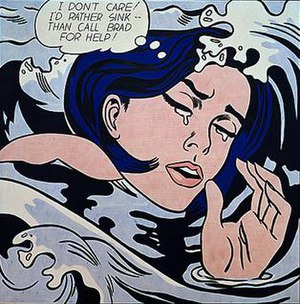Drowning Girl
| Drowning Girl | |
|---|---|
 |
|
| Artist | Roy Lichtenstein |
| Year | 1963 |
| Medium | oil and synthetic polymer paint on canvas |
| Dimensions | 171.6 cm × 169.5 cm ( 67 5⁄8 in × 66 3⁄4 in) |
| Location | Museum of Modern Art, New York City |
| 40°45′41.34″N 73°58′39.59″W / 40.7614833°N 73.9776639°WCoordinates: 40°45′41.34″N 73°58′39.59″W / 40.7614833°N 73.9776639°W | |
| Accession | 685.1971 |
Drowning Girl (also known as Secret Hearts or I Don't Care! I'd Rather Sink) is a 1963 painting in oil and synthetic polymer paint on canvas by Roy Lichtenstein. Using the conventions of comic book art, a thought bubble conveys the thoughts of the figure, while Ben-Day dots echo the effect of the mechanized printing process. It is one of the most representative paintings of the pop art movement, and part of the Museum of Modern Art's permanent collection since 1971. The painting is considered among Lichtenstein's most significant works, perhaps on a par with his acclaimed 1963 diptych Whaam!. Drowning Girl has been described as a "masterpiece of melodrama", and is one of the artist's earliest images depicting women in tragic situations, a theme to which he often returned in the mid-1960s.
The painting shows a teary-eyed woman on a turbulent sea. She is emotionally distressed, seemingly from a romance. A thought bubble reads: "I Don't Care! I'd Rather Sink — Than Call Brad For Help!" This narrative element highlights the clichéd melodrama, while its graphics reiterate Lichtenstein's theme of painterly work imitating mechanized reproduction. The work is derived from a 1962 DC Comics panel, while also borrowing from Hokusai's The Great Wave off Kanagawa and from elements of modernist artists Jean Arp and Joan Miró. It is one of several Lichtenstein works that mention a character named Brad who is absent from the picture. Both the graphical and narrative elements of the work are cropped from the source image.
During the late 1950s and early 1960s a number of American painters began to adapt the imagery and motifs of comic strips.Roy Lichtenstein made drawings of comic strip characters in 1958. Andy Warhol produced his earliest paintings in the style in 1960. Lichtenstein, unaware of Warhol's work, produced Look Mickey and Popeye in 1961. Although Warhol had produced silkscreens of comic strips and of other pop art subjects, he supposedly relegated himself to Campbell's Soup Cans as a subject at the time to avoid competing with the more finished style of comics by Lichtenstein. He once said "I've got to do something that really will have a lot of impact that will be different enough from Lichtenstein and James Rosenquist, that will be very personal, that won't look like I'm doing exactly what they're doing."
...
Wikipedia
